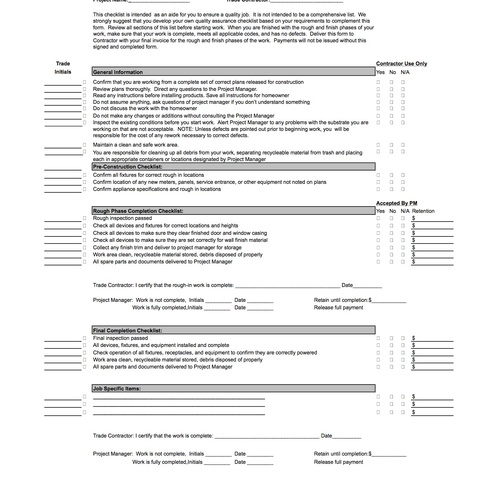
Way back when I was a contractor, I always found it useful to develop well-organized systems to use in running our business. Whenever I was asked the same question twice, it was time to create standards and procedures for employees and trade contractors to refer to.
I called these the gifts that kept on giving: once you had them you could stop trying to remember what you said the last time and just refer people to the appropriate documents. Eventually they learn, and the questions become less frequent.
Now, these gifts don’t come easily. They almost always take time to put together, troubleshoot, revise, implement, and then, most importantly, make sure that everyone uses them properly and consistently. There is nothing worse that putting together a great program only to have it ignored and abandoned.
Procedures must be effective, efficient, and used
As a manager, it is your job to create effective policies and procedures – ones that work and produce measurable results – and to enforce compliance with them throughout the company.
Company policies and procedures that don’t improve your productivity, comply with legal requirements, or provide you with information you can use are busy work and should be scrapped. Good policies and procedures that are ignored deprive you of increased productivity and data that you need to run your business better.
One of the best procedures we developed at my firm, SawHorse, Inc., was a trade contractor management program. At the time we put this together, we were running about 25 to 30 projects at any one time with six project managers and a small field staff of carpenters and laborers, the majority of our work being performed by trade contractors.
We needed a way to get both consistent quality work and manage the flow of information from proposals to invoices to payments smoothly. We already had in place good policies for invoicing and payments – invoices were due by a specific day and time every two weeks and checks were issued the week following receipt of invoices. We had moved from weekly payments to bi-monthly, saving our accounting department a lot of time and effort in the process.
Deciding to decide
What we didn’t have, however, was as good, consistent set of specifications for our trade contractors’ work, nor did we have a good process to inspect and confirm that the work was being done properly. We decided that we needed to fill this gap and made the decision to devote the time and energy to making it happen.
In setting out to create a system to manage our trade contractors, we outlined a program that included standard written construction specifications and a set of steps that required trade contractors to inspect their own work as well as have it inspected by our project managers prior to payments being released.
Putting this system together was no small feat – it took several months and hundreds of hours of work. We came up with a set of checklists and a written policy that we used to manage our trade contractors. We explained it, announced it in advance, used it for a test period, made some adjustments, and successfully implemented it quickly and with a minimum amount of disruption.
This article is the first in a series that will cover the steps we took putting this system in place, hiccups in the process, a detailed discussion of how the system works, and suggestions on how to create a process like this in your own company.
If you just can’t wait to get started on your own trade contractor management program, GBA Pro members can download the full set of checklists here. If you are not a GBA Pro member, and do not want to become one, you can go to my website and buy the full set of checklists. The set includes 26 individual checklists for most standard residential construction trades in Excel format along with a suggested procedure. You can personalize and edit each page as you see fit.
Click here to read the next article in this series
Weekly Newsletter
Get building science and energy efficiency advice, plus special offers, in your inbox.















One Comment
Interesting topic
Thanks for writing it up Karl. I hope I can get back to read up on the following articles in the series. You may enjoy a couple of the British NBS construction event series links that I left on the Green Architects Lounge comment thread recently. Regards, B.
Log in or create an account to post a comment.
Sign up Log in